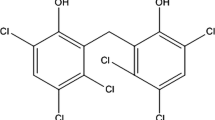Abstract
In present study, a reversed-phase dispersive liquid–liquid microextraction method followed by flame atomic absorption spectrometry as a low cost, easy operation, high sensitivity, and accuracy analytical approach has been developed for the analysis of lead(II) and cadmium(II) ions in cosmetic samples. For this purpose, the samples were diluted by toluene and then a mixture of diluted nitric acid solution and acetonitrile was used as the extraction solvent and disperser solvent, respectively. Effect of some important parameters on efficiency of the method was investigated to reach high enrichment factors. Under optimum experimental conditions, the calibration curves were linear in the ranges of 10.0–200 and 1.0–175 μg Kg−1 for lead(II) and cadmium(II), respectively. Moreover, relative standard deviations of the developed procedure for intra- (n = 6) and inter-day (n = 4) precisions were in the ranges of 3.4–6.5% ( C= 20 μg Kg−1 of each cation). Eventually, the suggested method was successfully used in analysis of the chosen ions in various cosmetic brands.



Similar content being viewed by others
Abbreviations
- EF:
-
Enrichment factor
- ER:
-
Extraction recovery
- FAAS:
-
Flame atomic absorption spectrometry
- LOD:
-
Limit of detection
- LOQ:
-
Limit of quantification
- RP-DLLME:
-
Reversed-phase dispersive liquid–liquid microextraction
References
Arpa Ç, Arıdaşır I (2019) Food Chem 284:16
Arshad H, Mehmood MZ, Shah MH, Abbasi AM (2020) Saudi Pharm J 28:779
Ayenimo JG, Yusuf AM, Adekunle AS, Makinde OW (2010) Bull Environ Contam Toxicol 84:8
Balarastaghi S, Khashaiarmanesh Z, Makhdoumi P, Alavizadeh SH, Moghadam ZS, Shirani K, Karimi G (2018) Toxin Rev 37:117
Brandão JDO, Okonkwo OJ, Sehkula M, Raseleka RM (2012) Toxicol Environ Chem 94:70
Cadorim HR, Schneider M, Hinz J, Luvizon F, Dias AN, Carasek E, Welz B (2019) Anal Lett 52:2133
Capelli C, Foppiano D, Venturelli G, Carlini E, Magi E, Ianni C (2014) Anal Lett 47:1201
Chamsaz M, Atarodi A, Eftekhari M, Asadpour S, Adibi M (2013) J Adv Res 4:35
de Jesus Ferreira V, Almeida JS, Lemos VA, de Oliveira OM, Garcia KS, Teixeira LS (2021), Talanta 222:121514.
Hashemi P, Raeisi F, Ghiasvand AR, Rahimi A (2010) Talanta 80:1926
Kalfa OM, Yalçınkaya Ö, Türker AR (2009) J Hazard Mater 166:455
Kazi TG, Afridi HI, Bhatti M, Akhtar A (2019) Ultrason Sonochem 51:40
Kilic S, Kilic M, Soylak M (2020) Biol Trace Elem Res 2020(199):2272
Liu S, Xie Q, Chen J, Sun J, He H, Zhang X (2013) J Chromatogr A 1295:16
Liu Y, Chu Y, Hu Z, Zhang S, Ma S, Khan MS, Chen F, Zhang D, Guo L, Lau C (2020) Microchem J 158:105322.
Lourenço EC, Eyng E, Bittencourt PRS, Duarte FA, Picoloto RS, Flores ÉLM (2019) Talanta 199:1
Maltez HF, Borges DL, Carasek E, Welz B, Curtius AJ (2008) Talanta 74:800
Massadeh AM, El-khateeb MY, Ibrahim SM (2017) Pub Health 149:130
Michalek IM, Benn EKT, dos Santos FLC, Gordon S, Wen C, Liu B (2019) Environ Res 170:187
Naeemullah, Tuzen M (2019) Talanta 196:71.
Narin I, Soylak M, Kayakirilmaz K, Elci L, Dogan M (2003) Anal Lett 36:641
Okamoto M, Kanda M, Matsumoto I, Miya Y (1971) J Soc Cosmet Chem 22:589
Özzeybek G, Şahin İ, Erarpat S, Bakirdere S (2020) J Food Compos Anal 90:103486.
Rezaee M, Assadi Y, Hosseini MRM, Aghaee E, Ahmadi F, Berijani S (2006) J Chromatogr A 1116:1
Şahan S, Saçmacı Ş, Şahin U, Ülgen A, Kartal Ş (2010) Talanta 80:2127
Sixto A, Mollo A, Knochen M (2019) J Food Compos Anal 82:103229.
Sorouraddin SM, Farajzadeh MA, Okhravi T (2019) J Iran Chem Soc 16:1537
Sorouraddin SM, Farajzadeh MA, Okhravi T (2020) J Food Compos Anal 93:103590.
Soylak M, Elci L (1997) Int J Environ Anal Chem 66:51
Soylak M, Yilmaz E (2011) Desalination 275:297
Wang W, Bao N, Yuan W, Si N, Bai H, Li H, Zhang Q (2019) Microchem J 148:240
Zafarzadeh A, Shahryari A, Taziki S, Ahmadi N, Mirkarimi K, Charkazi A (2018) Natl J Physiol Pharm Pharmacol 8:1200
Zhong Z, Li G, Luo J, Chen W, Liu L, He P, Luo Z (2015) Anal Methods 7:3169
Acknowledgements
The authors thank the Research Council of the University of Tabriz for financial support.
Funding
Saeed Mohammad Sorouraddin has received research grants from University of Tabriz.
Author information
Authors and Affiliations
Corresponding author
Ethics declarations
Conflict of interest
Saeed Mohammad Sorouraddin declares that he has no conflict of interest. Mir Ali Farajzadeh declares that he has no conflict of interest. Rana Pinou declares that he has no conflict of interest. Tohid Okhravi declares that he has no conflict of interest.
Ethical approval
This article does not contain any studies with human or animal subjects.
Informed consent
Not applicable.
Additional information
Publisher's Note
Springer Nature remains neutral with regard to jurisdictional claims in published maps and institutional affiliations.
Rights and permissions
About this article
Cite this article
Sorouraddin, S.M., Farajzadeh, M.A., Pinou, R. et al. Development of a reversed-phase dispersive liquid–liquid microextraction method for the extraction and preconcentration of lead and cadmium ions in some cosmetic products. Chem. Pap. 76, 2085–2092 (2022). https://doi.org/10.1007/s11696-021-01954-8
Received:
Accepted:
Published:
Issue Date:
DOI: https://doi.org/10.1007/s11696-021-01954-8




